Transaction Processing
Transaction Processing
- A transaction is a mechanism for describing logical units of database processing.
-
Transaction processing systems are systems with large databases and hundreds of concurrent
users. Some examples include:
- Airline Reservations
- Banking Systems
- Credit Card Processing
- Online retail Purchases
- Stock Markets
- Supermarket Checkouts
Single-User vs Multi-User Systems
- A DBMS is single user if only one user at a time can use the system
- A DBMS is multi-user if the system is access by multiple users at the same time (concurrently)
- Concurrency is achieved using the concept of multiprogramming. It allows the operating system to execute multiple processes at the same time
Interleaving
- Process A runs, at some time later is switched out (or on I/O)
- Process B runs, at some point later is switched out (or on I/O)
- Process A is switched in and continues, at some point later is switched out (or on I/O)
- This process repeats for the number of processes
- Hence, although we think these processes are running at the same time, they are actually interleaving
Transactions
- Transactions:
- are executing programs that forms a logical unit of database processing
- include one or more database access operations
- can be embedded within the application program or within the SQL server
- Whenever a transaction is submitted to a DBMS for execution, the system is responsible for making sure that all the operations in the transaction are completed successfully (COMMITTED) or If something goes wrong the database must not be updated (ABORTED)
- A transaction is a logical unit of instructions, if the transaction fails, all changes for that transaction must be rolled back
- Transaction
States and Additional Operations:
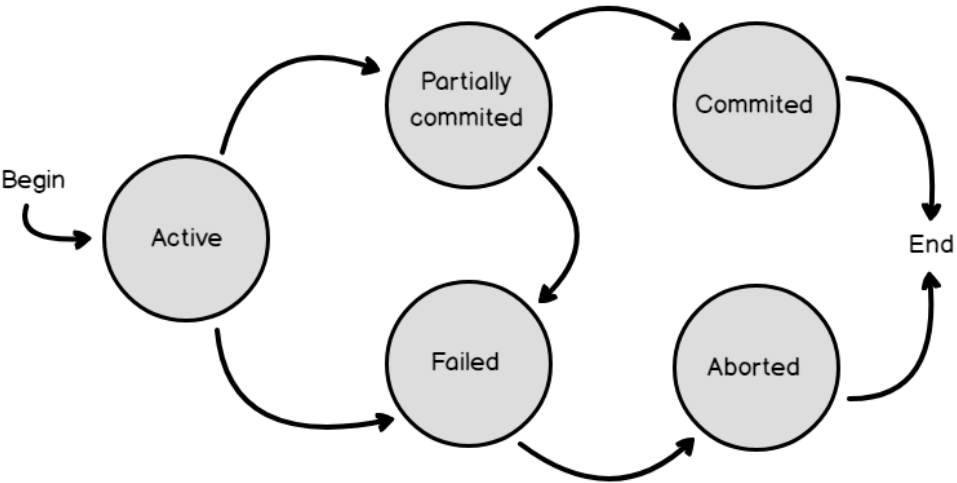
Concurrency Control
- Several Problems
can occur when concurrent transactions execute in an uncontrolled manner
- The Lost Update
- The Temporary Update (Dirty Read)
- The Incorrect Summary
- The Unrepeatable Read
ACID Properties
- Transactions
should possess several properties which are called the ACID properties
- Atomicity: A sequence of operations either all complete successfully or all fail
- Consistency: Data is never in an invalid state
- Isolation: Each operation is independent of other concurrent operations
- Durability: Data is safely stored in case of a system failure
Schedules
- A scheduled is defined as: S of n transaction T1, T2, … , Tn.
- When executing transactions concurrently in an interleaved fashion we need to create a schedule.
- A shorthand notation describing a schedule uses symbols b, r, w, e, c and a.
- Example:
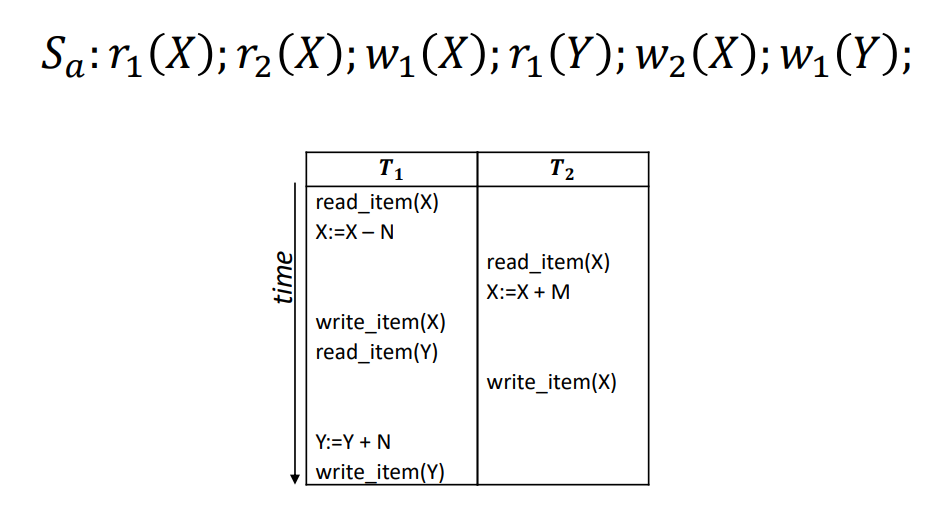
- Conflicting
Operations in a Schedule could result in inconsistent data! Two operations in a schedule are
said to conflict if they satisfy all three conditions
- 1: They belong to different transactions
- 2: They access the same item X
- 3: At least one of the operations is a write
-
Example:
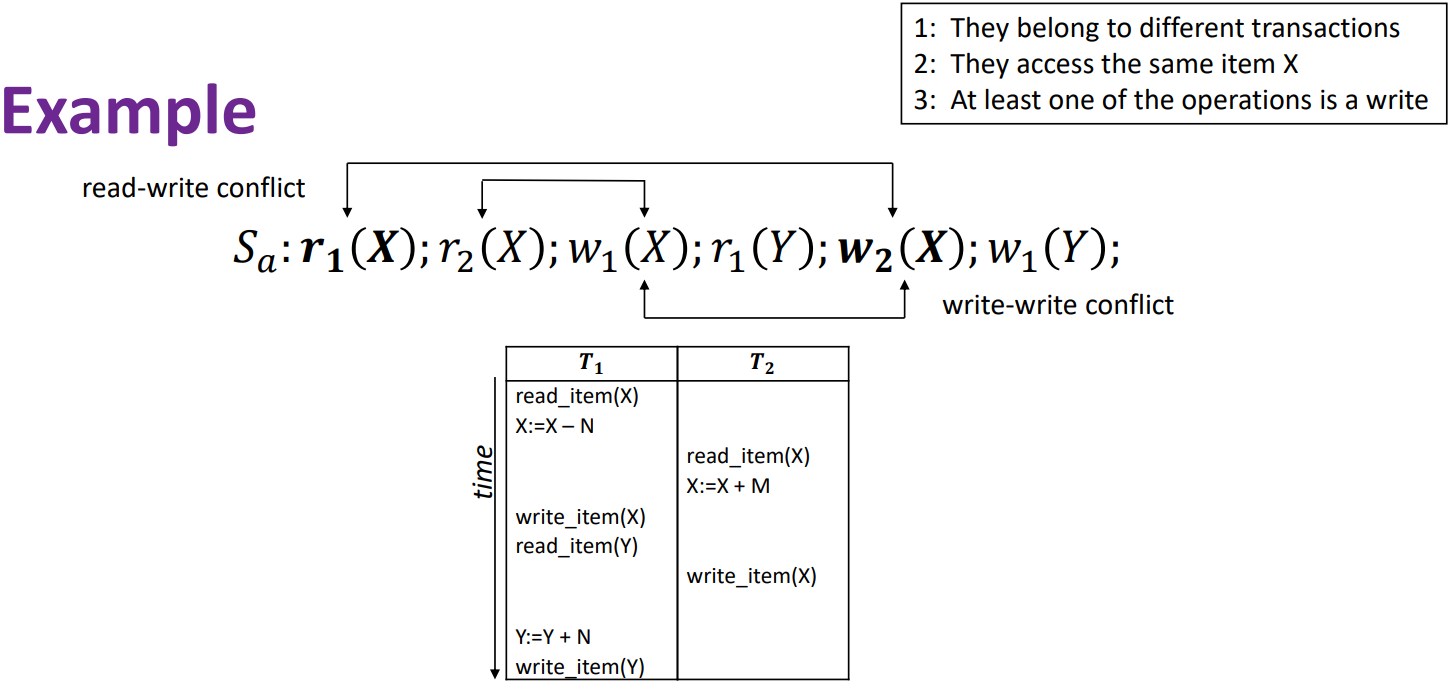
A Complete Schedule
- The goal is to
establish a complete schedule, which is defined as:
- The operations in S are exactly those operations in T1, T2, … , Tn.
- For any pair of operations from the same transaction, their relative order in S is preserved
- For any two conflicting operations, one of the two must occur before the other in the schedule
-
The Easy Approach:
-
Serial Schedules which run after the other in series.
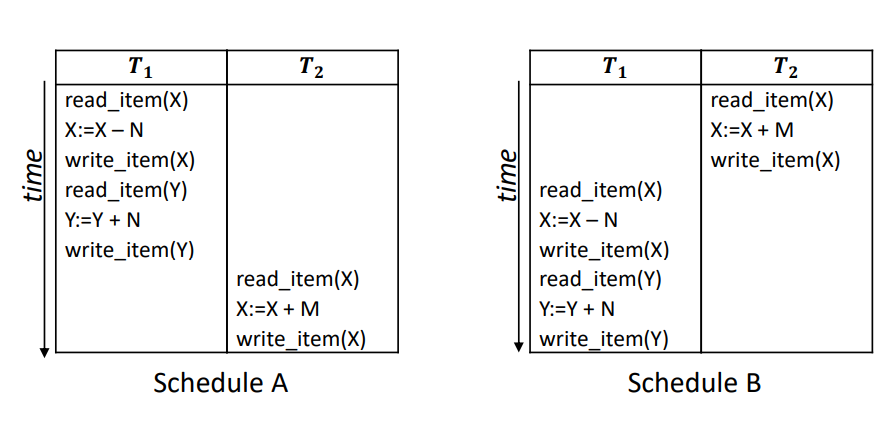
- With two transactions there can only be two possible schedules using a serial schedule.
- Unacceptable in practice due to long I/O waits (no switching). A large transaction might hog the CPU
-
Serial Schedules which run after the other in series.
-
Allowing Interleaving:
-
Interleaving of Transactions results in many possible schedules, here are
two examples:
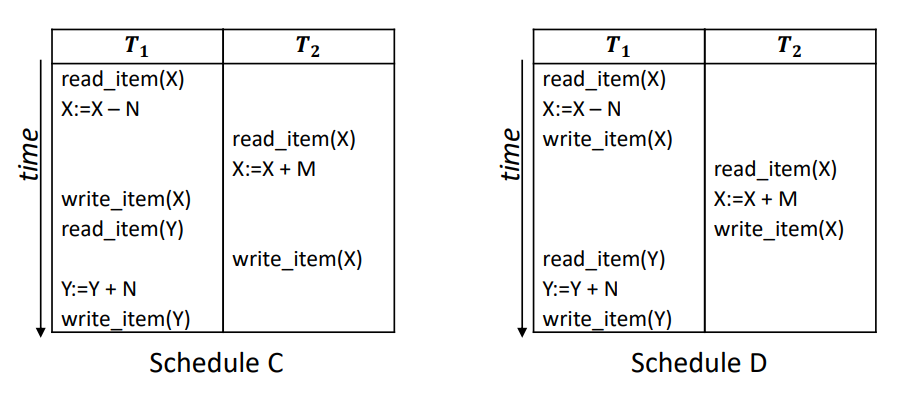
- Non-serial is a bit hit or miss and can give us wrong results but we want non-serial because of concurrency.
-
Interleaving of Transactions results in many possible schedules, here are
two examples:
-
Serialisable Schedule:
-
- A schedule S of n transactions is serialisable if it is equivalent to some
serial schedule of the same n transactions

- There are n! possible schedules of serial transactions (many more for non serial schedules)
- Result Equivalent: In the simplest terms, compare the results of a serial schedule to that of a non serial schedule.
- The safe approach is to focus only on the read and write operations of the transactions. Don't make assumptions about the other internal operations included within the transactions.
- Two schedules are equivalent if the operations applied to each data item affected by the schedules should be applied to that item in both schedules in the same order.
- The most common approach to equivalence of schedules is the conflict equivalence.
-
- A schedule S of n transactions is serialisable if it is equivalent to some
serial schedule of the same n transactions
Conflict Equivalence Of Two Schedules & Serialisable Schedules
- Two schedules
are said to be conflict equivalent if the relative order of any two conflicting operations
is the same in both schedules.
- Different transactions
- Access the same data item
- Both or one is a write operation
- Not Conflicting Equivalence is when conflicting operations are applied in different orders in two schedules.
- S is serialisable if its (conflict) equivalent to some serial schedule
- Therefore, by
reordering the operations in a schedule it could become serialisable

Practice Question
Which of the following statements about transaction processing and scheduling in database systems are correct?
End Of Week Quiz
Note: A score of 70% or higher would mean you
have successfully completed the week 8 workshop
